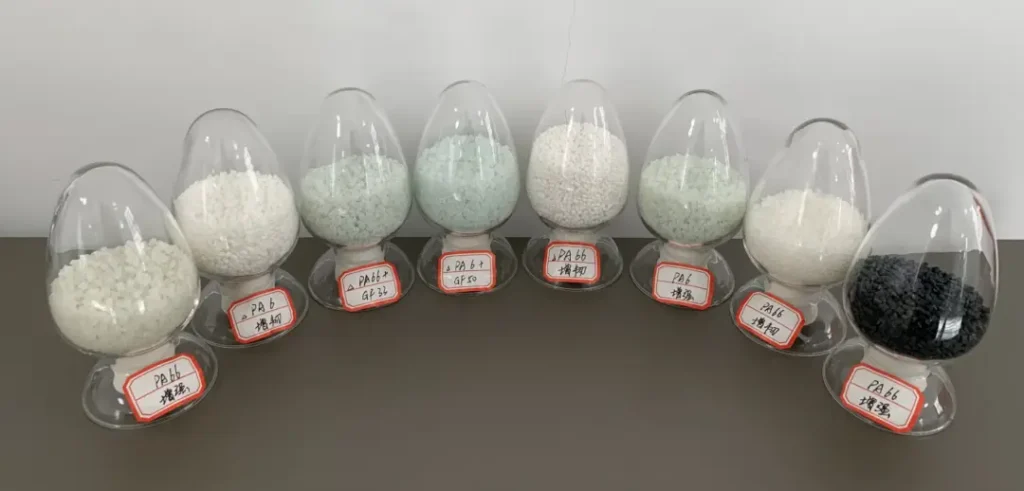Poliamidai, paprastai vadinami nailonais, yra plati inžinerinių termoplastikų grupė, vertinama dėl savo tvirtumo, universalumo ir atsparumo cheminėms medžiagoms. Šioje grupėje PA6 ir PA66 yra du svarbūs nariai, kurie gali būti painiojami dėl panašių pavadinimų ir bendros pagrindinės medžiagos. Šiame vadove aptariami pagrindiniai PA6 ir PA66 skirtumai, kad medžiagų inžinieriai galėtų priimti pagrįstus sprendimus savo projektuose.
PA6 ir PA66 panašumai:
- Tiek PA6, tiek PA66 yra stiprūs, dilimui atsparūs termoplastai, pasižymintys geru atsparumu cheminėms medžiagoms.
- Jie plačiai naudojami automobilių dalims, plataus vartojimo prekėms ir įvairiose pramonės srityse.
PA6 (poliamidas 6):
- Privalumai:Lengviau apdoroti dėl žemesnės lydymosi temperatūros, todėl gamybos sąnaudos gali būti mažesnės. Geras kietumas ir atsparumas smūgiams. Dėl geresnio hidrolitinio stabilumo pasižymi geresnėmis eksploatacinėmis savybėmis drėgmės veikiamose srityse.
- Trūkumai:Mažesnis atsparumas temperatūrai, palyginti su PA66, todėl jis dažniau deformuojasi esant dideliam karščiui. Didesnis drėgmės įgeriamumas gali lemti matmenų pokyčius.
PA66 (poliamidas 6,6):
- Privalumai:Puikus atsparumas temperatūrai ir mechaninis atsparumas, todėl idealiai tinka sudėtingoms reikmėms. Išlaiko geras eksploatacines savybes aukštoje temperatūroje. Mažesnė drėgmės absorbcija gali prisidėti prie geresnio matmenų stabilumo.
- Trūkumai:Sudėtingiau apdoroti dėl aukštesnės lydymosi temperatūros, todėl gali padidėti gamybos sąnaudos. Brangiau nei PA6.
Kaip pasirinkti tinkamą medžiagą:
- Aukštos temperatūros eksploatacinės savybės ir stiprumas:PA66 yra aiškus nugalėtojas.
- Apdorojimo paprastumas ir sąnaudos:PA6 turi pranašumą.
- Atsparumas drėgmei:PA6 gali būti geresnis pasirinkimas dėl jo hidrolitinio stabilumo, tačiau reikia atsižvelgti į bendrą drėgmės absorbcijos poreikį, kad būtų užtikrintas matmenų stabilumas.
PA6 VS PA66 Papildomos pastabos:
- Atsparumas liepsnai:Kai kurios PA6 ir PA66 atmainos, atsižvelgiant į naudojimo reikalavimus, gali būti su antipireniniais priedais.
- Trinties savybės:PA6 gali pasižymėti geresnėmis savaiminio tepimo savybėmis tam tikrose srityse, palyginti su PA66.
- Atsparumas nuovargiui:PA66 paprastai pasižymi geresniu atsparumu nuovargiui ciklinės apkrovos sąlygomis.
Optimalios medžiagos tarp PA6 ir PA66 pasirinkimas priklauso nuo konkrečių jūsų taikomosios programos reikalavimų. Atidžiai įvertinkite tokius veiksnius, kaip atsparumas temperatūrai, apdorojimo poreikiai, išlaidų apribojimai, drėgmės poveikis, degumo reikalavimai, trinties savybės ir atsparumas nuovargiui. Suprasdami skirtingas PA6 ir PA66 savybes, medžiagų inžinieriai gali priimti pagrįstus sprendimus, užtikrinančius projektų sėkmę.

